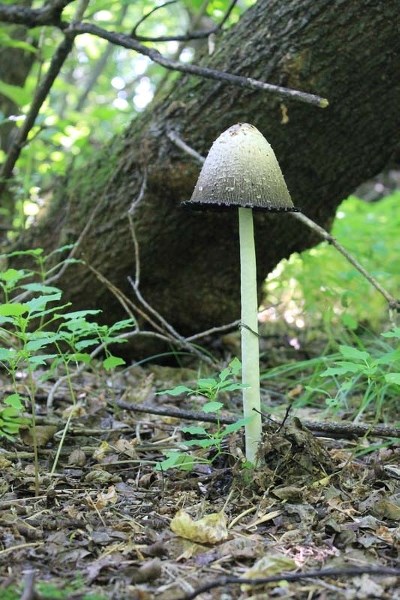Local mycophiles can get some free eats this weekend as part of Alberta’s annual edible mushroom show.
The Alberta Mycological Society is hosting its annual City of Champignons Mushroom Exposition this Sunday at the Devonian Botanical Garden. The show features hundreds of mushrooms and mushroom experts from across Alberta, as well as free mushroom seminars and snacks. It typically draws about a thousand guests.
Mushrooms are the fruits of fungi, says Martin Osis, past-president of the mycological society, which are hair-like decomposers found virtually everywhere. “Fungi are the main engines of your compost pile,” he notes, and important symbiotes for most trees. Many are also edible.
Heavy rains have made this a great year for mushrooms in Alberta, Osis says, with rarities such as the deadly destroying angel mushroom (pale white, fatal if swallowed) popping up everywhere. “We’re finding all kinds of rare fungi that we typically don’t find.”
One of the biggest finds was three weeks ago, he says, when society members spotted a group of coprinus colosseus mushrooms in Edmonton’s Whitemud Creek ravine. “It’s like a big, souped-up shaggy mane,” he says (i.e. a big, shaggy Q-Tip) and was not previously known to grow outside Washington state. “It was right about 19 to 20 inches tall (about half a metre), and there was a whole pile of them.”
St. Albert usually has plenty of edible mushrooms, says local mycophile Elke Blodgett, such as the agaricus campestris (white top, chocolate gills, often on lawns), fairy ring and giant puffball, but most of her favourite local spots have been bare this year. “It bothers me,” she says, as that could be a sign of pollution problems.
Researchers aren’t sure what causes fungi to fruit, Osis says, so there’s no guarantee that they’ll pop up in the same place every year. “That’s part of the mystique of mushrooms,” he says. “It’s like going hunting for Easter eggs, except the problem is you don’t know if it’s Easter or not.”
The event runs from 11 a.m. to 4 p.m. at the Devonian Botanical Garden near Devon this Aug. 18. The event is free with admission. Visit www.wildmushrooms.ws for details.
Got swimmer’s itch? Then an Edmonton researcher wants you to tell him about it.
Parasitologist Patrick Hanington is doing a nation-wide study of swimmer’s itch this summer at the University of Alberta. Once complete, it should help swimmers learn which lakes are most likely to give them a case of the nasty rash.
Swimmer’s itch is an allergic rash caused by a parasitic flatworm, Hanington says, one that’s carried by snails and invisible without aid of a microscope.
Birds and rodents poop out flatworm eggs that hatch into paramecium-like creatures, he explains, which infect local snails. The flatworms feed off the snail and reproduce into thousands of tadpole-like worms that burrow free over the course of a month. “It can be pretty gruesome from the snail’s point of view.”
These worms ordinarily infest ducks and rodents, Hanington says, but they can also attack people. “The parasite will burrow into your skin and be stopped by your immune response.” The parasite dies, and the person gets a mosquito-bite-like rash.
Hanington’s team is collecting snails from about 20 Alberta lakes this summer, including Lac Ste. Anne and Isle Lake, to try and learn more about these parasites. He’s also asking residents to report cases of swimmer’s itch at swimmersitch.ca.
The team has received about 200 itch reports so far from 65 lakes, Hanington says. Twenty-three of those lakes are in Alberta. “I’d be surprised if there was any lake in the province that didn’t have some level of the swimmer’s itch parasite.” The team hopes this research will help them predict peak times for swimmer’s itch and help swimmers better avoid it.
Swimmers can reduce their risk for itch by sticking to areas cleared of reeds, Hanington says, as infested snails like decaying vegetation. The itch itself can be treated with a corticosteroid cream.
Visit swimmersitch.ca for details.




